Coming soon: the first of Metro Vancouver’s next-generation trolley buses
Coming soon: the first of Metro Vancouver’s next-generation trolley buses
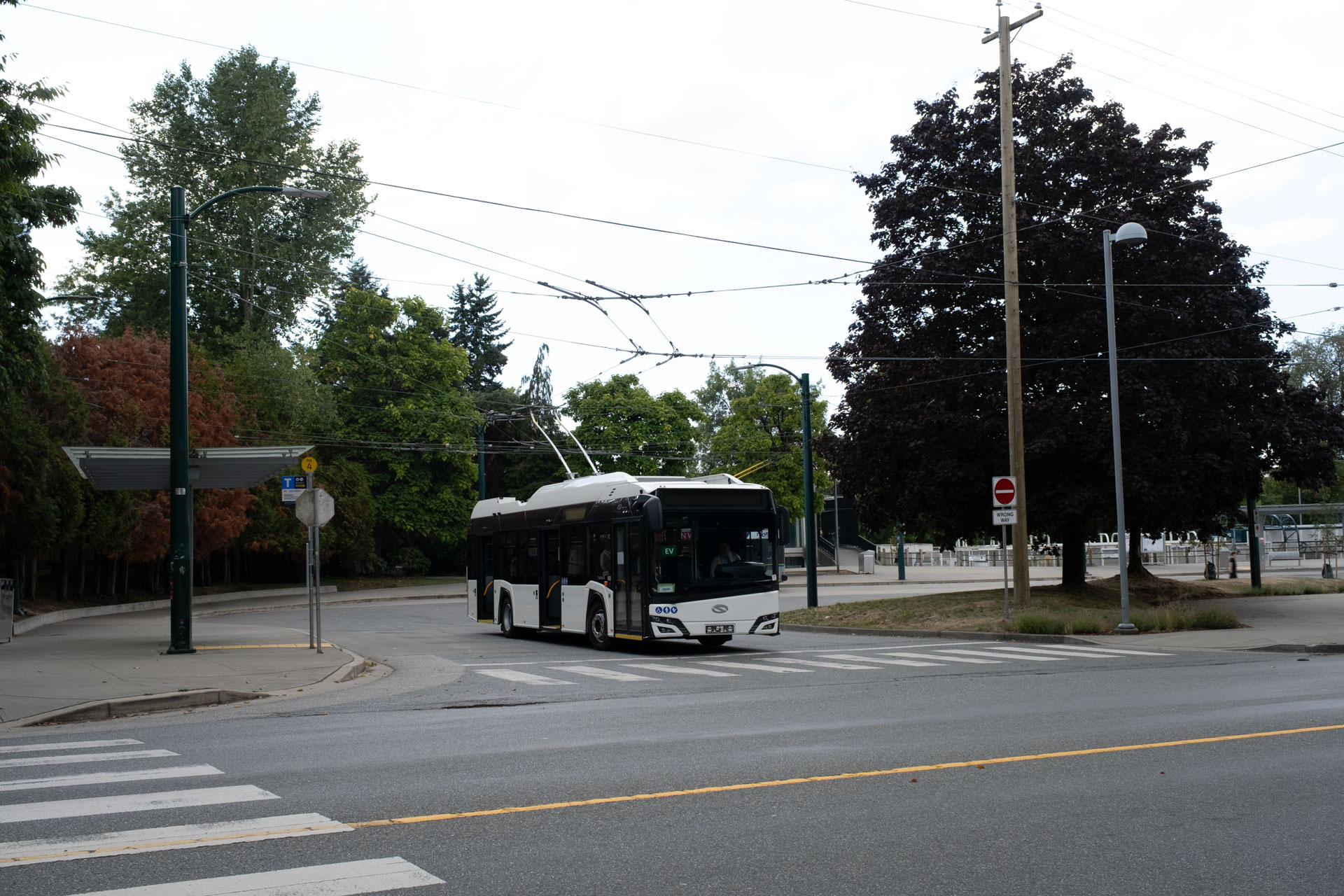
We have some electrifying news to share that will have you buzzing!
After two decades on the road and racking up more than 205 million kilometres on the odometer, our current trolley buses are reaching the end of service life so we’re replacing them.
We’re renewing our fleet of 262 trolley buses, which currently consists of 188 40-foot buses and 74 60-foot buses, with new buses from Solaris Bus & Coach.
Solaris is one of the leading zero-emission transit bus manufacturers in Europe.
Our next-generation trolley bus fleet will consist of the Solaris Trollino 12 (standard, 40-foot bus) and Trollino 18 (articulated, 60-foot bus). The buses will use a propulsion system from MedCom and destination signs from Luminator.
We will receive 107 40-foot trolley buses to start. The contract includes options for additional buses, which will allow us to completely replace our current fleet of 262 trolley buses. The options, if fully exercised, is for up to 201 additional 40-foot buses and up to 204 articulated, 60-foot trolley buses.
Like our current buses, the Trollino is a low-floor bus, allowing step-free boarding and passengers who use a wheelchair to roll on and off.
What’s new
These are our first trolley buses to be air conditioned for customer and operator comfort and have in-motion charging — the latest in trolleybus technology. It allows buses to draw power from the overhead wires for both driving and charging its on-board battery.
This means the new trolley buses will be able to operate away from overhead wires for about 20 kilometres.
This opens the possibility for where trolley buses can go in the future. It includes bus routes where there are trolley overhead wires for only part of the route or during temporary detours that currently require switching to diesel buses.
Our current trolleys can only travel a couple hundred metres using their on-board battery and are designed to travel around blockages, not for regular operations.
Design underway
In-motion charging is a proven technology and in use worldwide. As part of our efforts to understand it and how it would work in Metro Vancouver, Solaris demonstrated its bus in Vancouver during summer 2023.
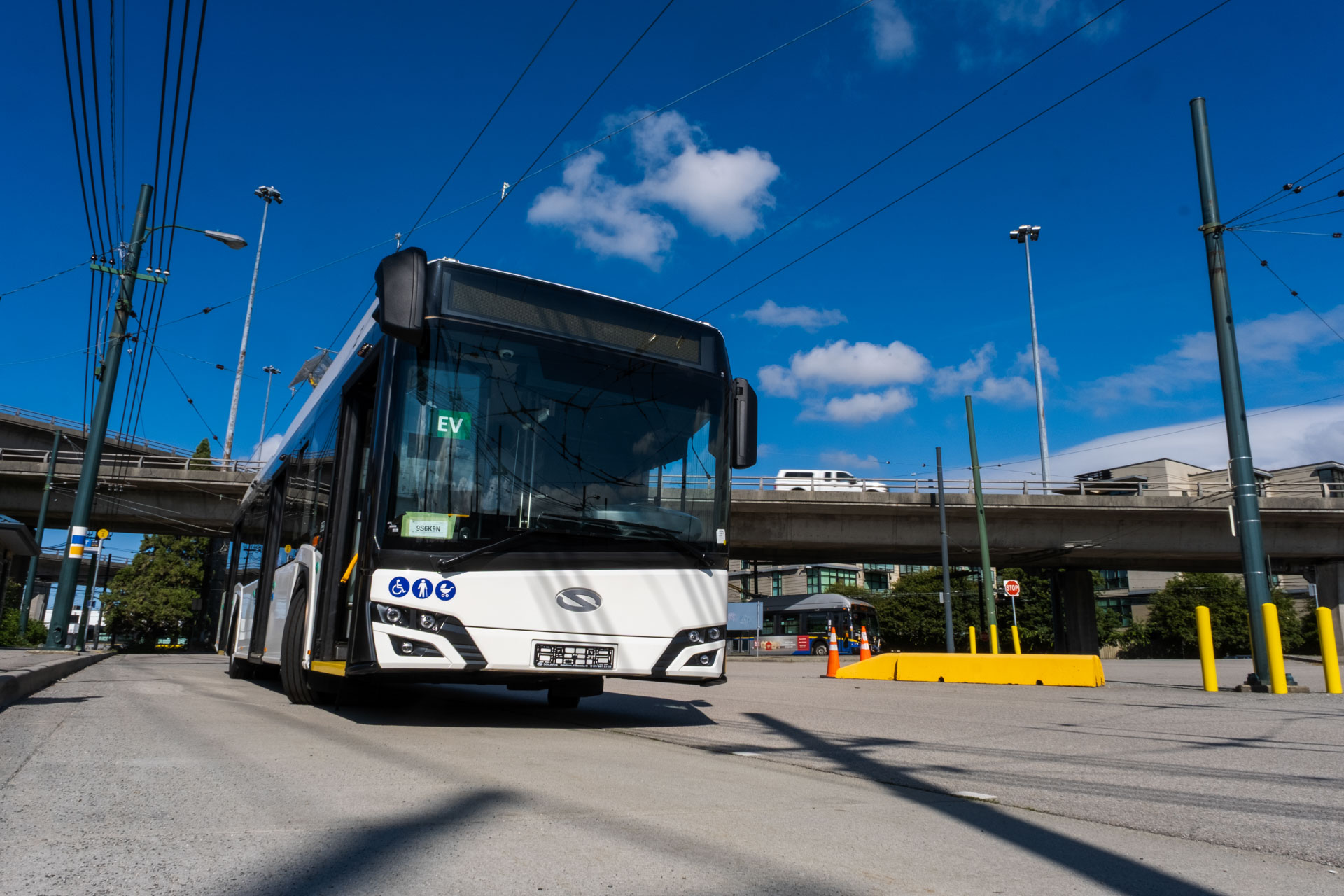
Eagle-eyed readers may notice that bus had a third door at its rear. Buses are built according to the specifications of each transit agency, and that bus was built for a different agency.
Our buses will follow Coast Mountain Bus Company’s specifications. Design is currently underway, and customers can expect that when the new trolley buses join our fleet, they’ll be similar to our current buses.
The first pilot bus is scheduled to arrive sometime next year. This will allow us to fine-tune specifications and gather operating data before the rest of the trolley buses start to roll off the assembly line in the coming years.
The buses will operate out of our Vancouver Transit Centre bus depot, our home base for the trolleybus fleet.
It is the second largest in Canada and the United States and we’re currently the only transit system in Canada that operates trolley buses.
This reflects our commitment to electric transit.
A love affair with electric transit
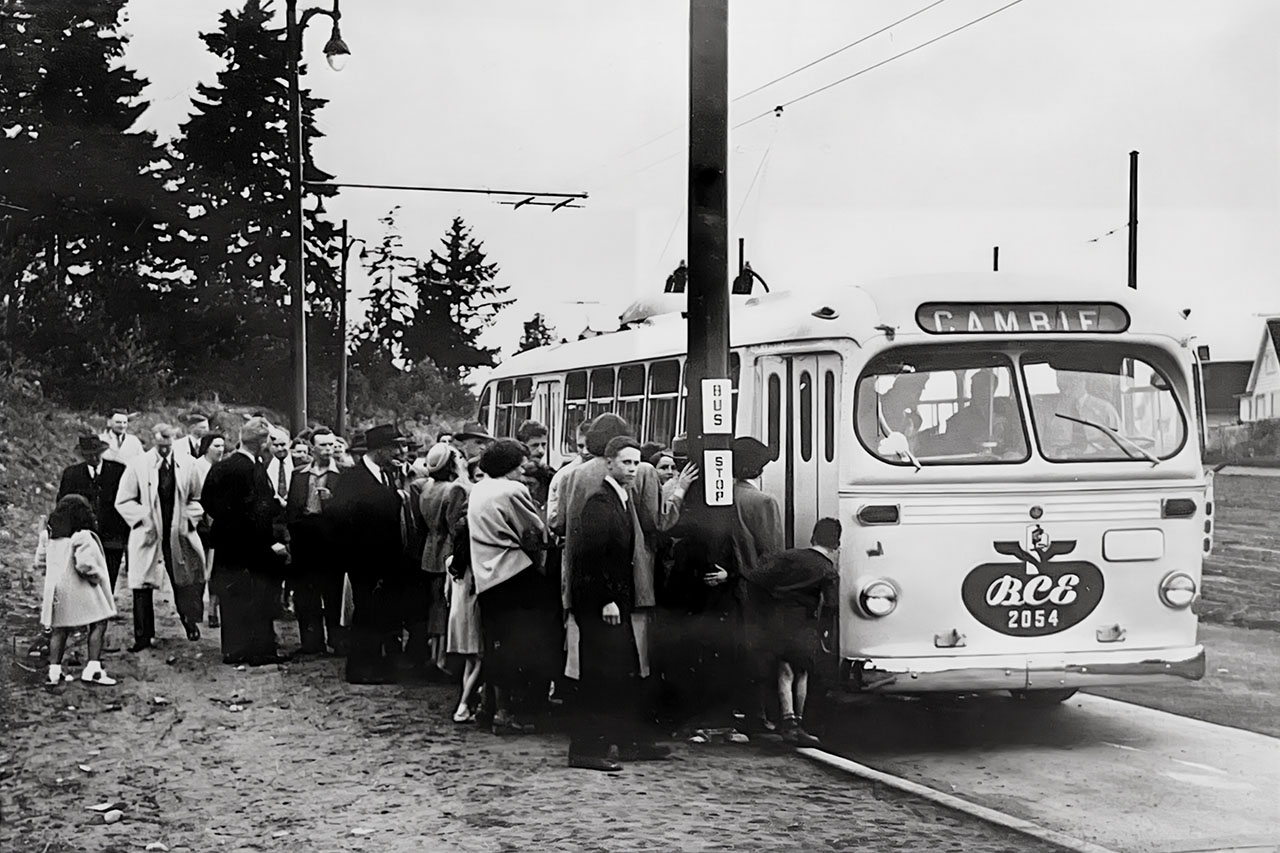
Metro Vancouver has had a long-standing love affair with electric transit since the very beginning.
The first transit vehicle in the region was an electric streetcar that rolled down Main Street in Vancouver on June 27, 1890.
Then, on Aug. 16, 1948, the first electric trolley bus and route arrived as part of the start of the “rails-to-rubber” conversion to decommission and replace the streetcar network with buses.
In 1985, the SkyTrain, an electric rail rapid transit system, arrived. And just over 70 years after our first trolley-electric bus, we added our first battery-electric buses to our fleet in 2019.
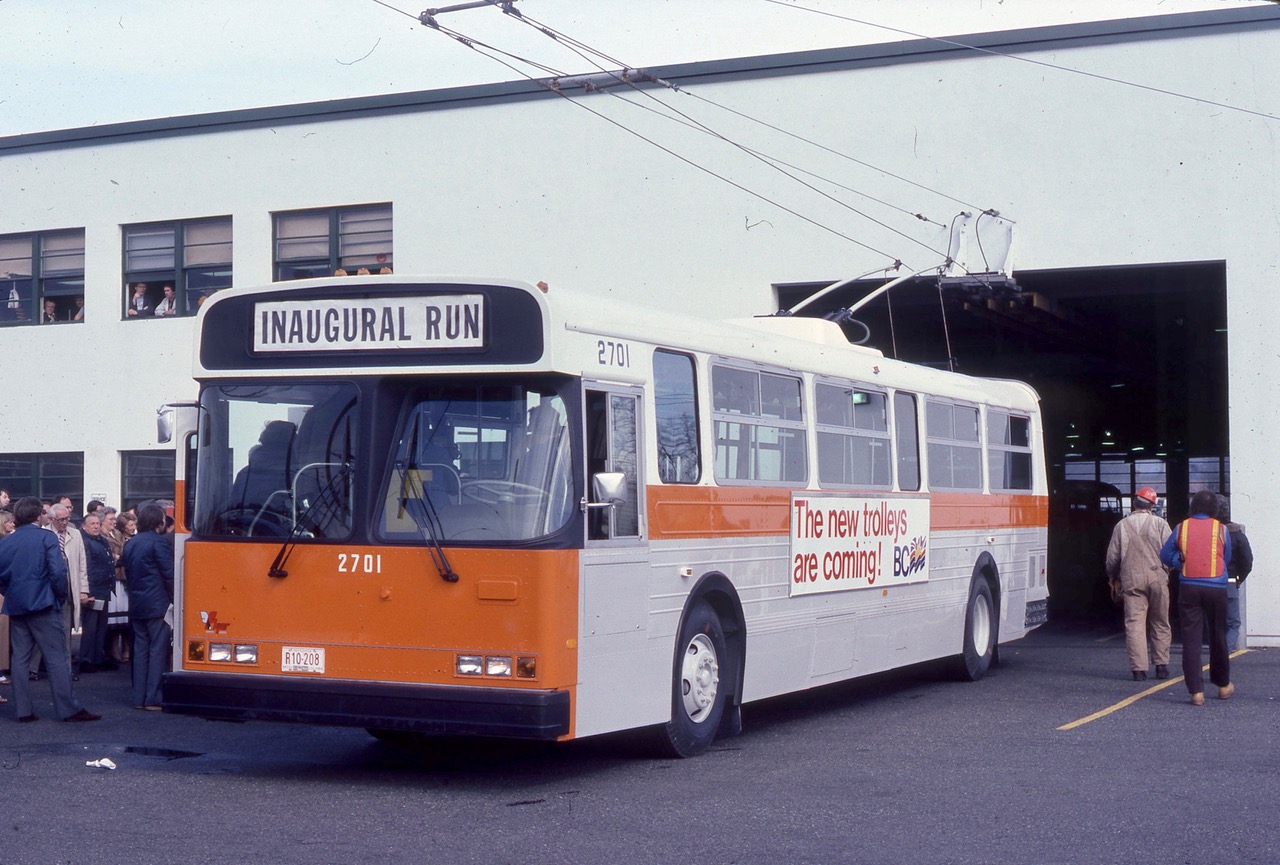
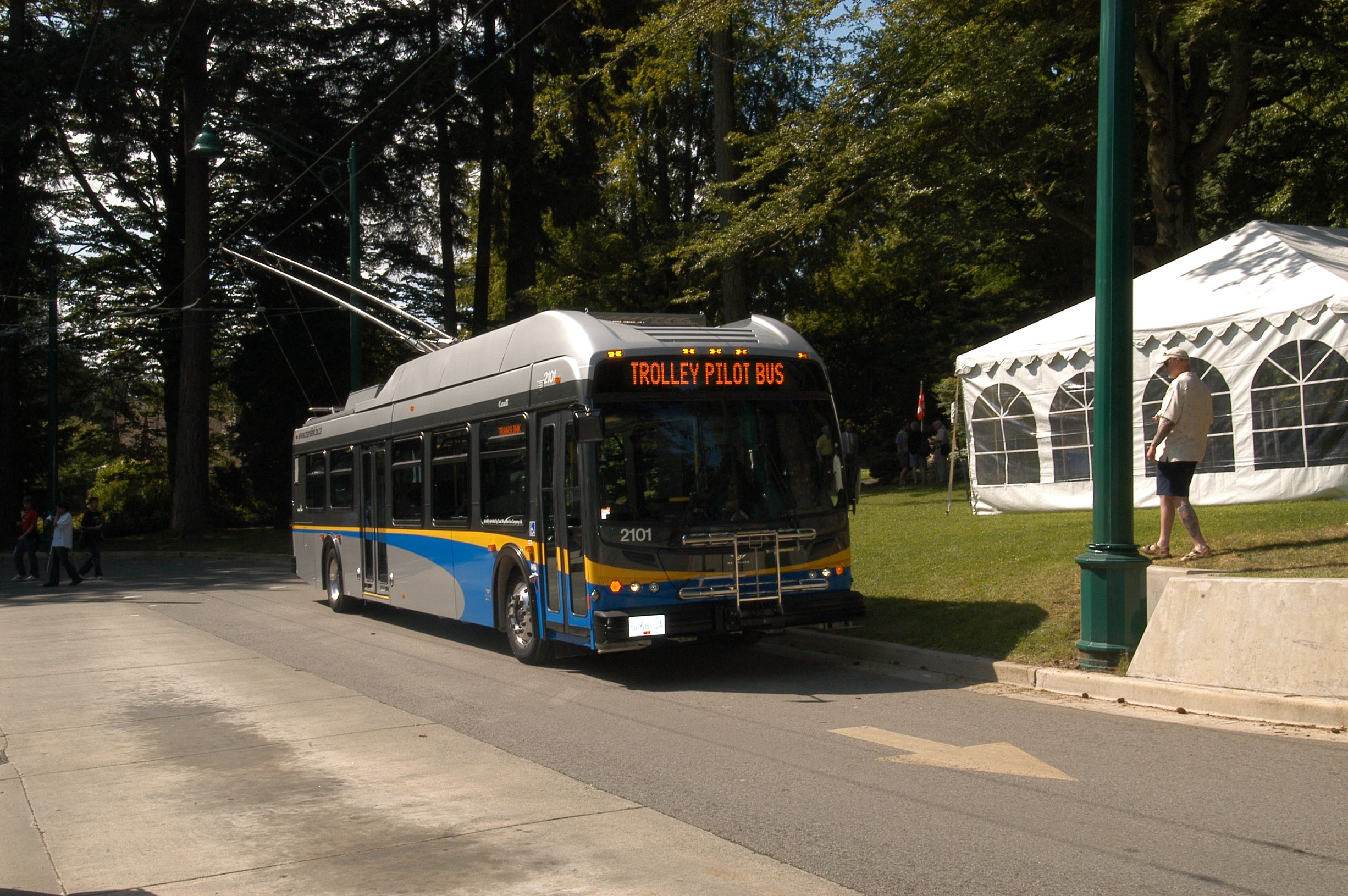
In total, three generations of trolley buses have roamed the streets of Vancouver and we’re excited to welcome a fourth.
Just as you might get estimates from different contractors for a home improvement project, we asked for bids from bus manufacturers through a formal and competitive request for proposal process.
Solaris was chosen for its ability to deliver a cost-effective bus that meets our needs for a purpose-built and lightweight trolley bus, as well as our need to start replacing the current trolley buses beginning in 2026.
Our current trolleybus fleet will reach its 20-year service life between 2026 and 2029. Parts are expected to become harder to find, leaving our current trolley buses vulnerable to breakdowns and potentially reducing services for customers.
The new trolley buses will ensure continued safe and reliable service for our customers into the 2040s.
They also play a key role in helping us achieve our goal of fully transitioning to a zero-emissions fleet by 2040 and net-zero greenhouse gas emissions by 2050.






This is great news! It is a shame that TransLink is still ordering their buses with Luminator destination signs. Would be great to have the procurement team consider destination signs from Hanover.
I think it’s disgusting they didn’t buy from a Canadian Company. New Flyer is based in Winnipeg. Nova Bus is in Quebec, although owned by Volvo out of Europe.
New Flyer has a massive order backlog (15,000 vehicles), and Nova doesn’t make trolley buses.
Thing is, David… New Flyer is not as Canadian as you might think. They are partly owned by a Brazilian company. All the manufacturing for New Flyer is now in America. There are many problems with New Flyer. The major one, which is a major contributing factor, is that the build quality of New Flyer is very sub par. There is a very big order backlog of buses at New Flyer, and there is just no time for New Flyer anymore. The Canadian company, mainly operating in America is no longer a feasible manufacturer to buy from. The main interest if to buy buses that work, not buses that keep needing repairs every week.
Pipe down gobby Bobby.
Happy to see more European buses operating in Canada. NFI make decent trolley buses, but cost and procurement delay are part of the equation. In the long run, Canadian bus manufacturers will only benefit from the European competition. We could learn a lot from their 100% low-floor design. Vancouver needs the best the world has to offer.
I don’t know if you were here when they inaugurated the Flyers from Winnipeg several years ago, but they performed terribly in one of our infrequent snowstorms in November. I seem to remember they didn’t handle the road salt either.
Another long time transit user.
That third door at the back of the 12-meter Solaris would be extremely useful for many of our routes. Especially down the Granville strip in downtown where there are a lot of people riding only a few stops at a time, the three-door configuration will help reduce dwell time at stops and improve accessibility onboard.
I second this! Current North American bus models are so infuriating… if you’re at the very back of a full bus and want to leave, you then have to fight your way to the middle!
👍👍💯
If we are concerned that our bus stops are not yet ready for 3 or 4 door buses… can we not just turn the last set of doors on/off with a switch?
Definitely agree, especially most of the routes which is using the trolley buses are busy areas, 3 doors version is more necessary~~
Totally agree on the extra doors being really useful! People would get on and off the bus so much quicker. Hopefully Coast Mountain will reconsider and move away from this “North American” standard.
Is it possible to tap our compass card quicker? There’s a delay between taps. Like how we scan our grocery’s fast.
The Vancouver trolley buses would certainly benefit from the third rear door.
New Flyer’s backlog at 10,000+ units is a deterrent for NA transit agencies these days, seems like a bold decision by TransLink to go with an overseas manufacturer. The big question now is where and how these buses will be manufactured.
Looking forward to seeing where it’ll run! Especially on sections without wires as part of its regular service (likely e.g. 160 where 80+ km/h section likely begins east of Barnet Rd @ 7600 block for eastbound buses and north of Barnet Hwy @ View St for westbound buses, and ends north of Barnet Hwy @ Gore St for eastbound buses and east of Barnet Rd @ 7500 block at least for westbound buses) so trolleybuses can travel at higher speeds and on more kinds of roads including highways.
When exactly beginning the new buses?
How are you generating the additional electrical power for the likely increased power draw as part of the transistion to clean energy?
it’s 2025. Move on from trolleys. they have all the disadvantages of being a tram without having any of the advantages and have all the disadvantages of being a bus without any of the advantages. Move on.
The advantage of not being a tram is it is far cheaper to string cable for routes than to lay tracks. And they have the flexibility to switch lanes or drop pole and go around collisions; a 20km off-pole range is even more flexible.
The advantage of not being a diesel bus is they are clean and quiet. A pair of poles is also way, way cheaper than giant batteries, so more buses for your dollar; a very key factor.
Did you put in a tender for a fleet of hovercraft to replace the trolleys that you so despise?
Being a tram without being a tram is exactly the point you dingus. Would you rather be like Toronto where their streetcars get blocked by cars every single day?
A trolleybus can maneuver around obstacles and modern models can handle going off-wire for extended periods. They have every advantage of a traditional bus while being zero emission and more reliable than a battery bus.
People who think trolleybuses are outdated are always some of the most ignorant out there.
new flyer is the only trolleybus maker left in na as Nova Bus does not make trolleybuses for those who don’t know great news for us trolleybus lovers we are the only Canadian city that still has them translink could change how other na transit companies look at where to buy trolleybuses from now for what transport Canada has to say as they have all the say on safety etc.
Hope they can driven in the BC snow because our current ones are still not living up to expectations.
The Skytrain doesn’t do so well in the snow either; putting drivers on every train, door attendants w/hockey sticks and driving them through the night notwithstanding.
We need work in canada especially now with tariffs etc. they should assemble or create work for Canadians
Any opportunity to employ Canadians is a must in these horrific economic times. Shame on you TransLink.
Also why is there no fix for fare evaders. This is absolutely in unacceptable. If you ride you pay Period !!!!!!!
Shut up
While we’re discussing “Only in Vancouver” transit successes, let’s get some more Seabuses instead of waiting on a pipe dream of multi-billion North Shore Skytrain extension. At ~$30M a pop, a fleet of 10-12 Seabuses could provide 2-3 minute service; the same frequency and capacity as Skytrain, but 90% cheaper! And they work in the snow and come with wonderfully relaxing view!
Interesting. TransLink totally missed the real second generation trolleybus — the Flyer E700s. While they didn’t completely replace the Brills, they run side-by-side, they were a modern vehicle in the 1970s. I miss the clunka-clunka rear axle. A little character.
But I’m really glad of the new order for the Solaris Trollino. While Canadian made would be great, it’s nice to European innovation.
Now instead of going battery on many other routes, let extend the trolleybus network on routes like the 119, 123, 106 and so on. Real workhorse routes.
A city of a size of Vancouver definitely needs three-door single buses (vs. two-door) and four-door articulated buses (vs. three-door) which makes boarding much faster and more efficient Two-door buses are more suitable for smaller towns, and Vancouver had surpassed that a long time ago. The new trolley busses must be equipped with reliable air-conditioning system. Drivers should be isolated by a cabin and discontinue the practice of communicating and chatting with the passengers, or dealing with fare payments, which would allow them to safely drive and not serve as trour guides or counsellors.
I wish Translink would just get rid of trolley buses altogether. When it disconnects from the overhead wires, it plugs up the road.
y yyyyy
If the batteries are capable of rapid charging, it could be done intermittently at stops allowing more flexibility in routing. Even better would be adoption of the O-Bahn self guiding mod which allows buses to run on simple separated guideways (at Skytrain speeds of 90 Kph, in Adelaide, Australia) then leave to run routes on normal streets, great load factor balancing capability and flexibility for changing housing locations. https://en.wikipedia.org/wiki/O-Bahn_Busway
North America is so far behind in desighn and build of busses and trollies. Take a look at Basel in Switzerland and the #50 bus from the Europort to the main train station is a multi door centepeid that can even circumvent a roundabout.
Uuuuuuuuiiiikooopjjjjmmn
Last batch of new flyers, have issues with transmission, and braking, poorly made
Is it possible to tap our compass card quicker? There’s a delay between taps. Like how we scan our grocery’s fast.
The writing in this article is surprisingly poor.
I would like to see an expansion of trolley 🚎 busses through out New Westminster; there is only one that goes to Metrotown, which should be expanded to Edmonds.
There should also be three other trolley 🚎 routes added, one along Canada way, another along Willington from Metrotown to Kootenay loop, & another from Brentwood to Boundary, hopefully reinstating the Broadway trolley 🚎 route.
I am surprised to see you pointing out the third door as a “flaw”. The consensus is usually that allowing all-doors boarding and increasing the number of doors will reduce the bus dwell time. Why wouldn’t you want to include a third door in your bus specifications?
Ngl, I think the E40LF/E60LF are kinda iconic. I don’t want them to be replaced because I feel like the entire environment is going to be more Russian. I already like the E40LF/E60LF. (Btw I want SCBCTA to unban me 🙏)
Haven’t you forgotten the bike rack?